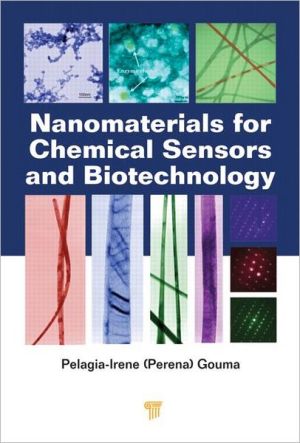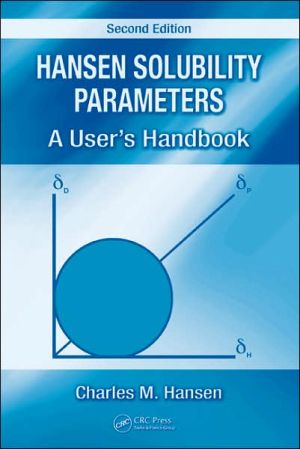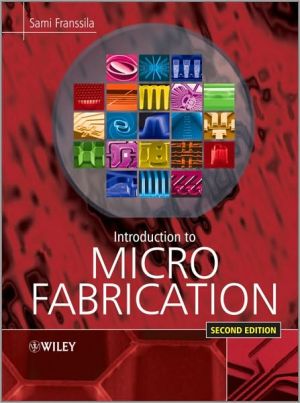Nanomaterials for Chemical Sensors and Biotechnology
A guide to the interdisciplinary fields of nanomaterials, sensors, and biotechnology, this book demonstrates functional applications of nanotechnology in diverse areas such as environmental sensing and space habitation, medical diagnostics, and tissue regeneration. With a focus on novel materials synthesis, such as using the nanomanufacturing technique of electrospinning to get the longest nanowires possible, a correlation is made of the effect of chemical, structural, and morphological...
Search in google:
A reference guide to the interdisciplinary fields of nanomaterials, sensors, and biotechnology, this textbook demonstrates functional applications of nanotechnology in diverse areas such as environmental sensing, space habitation, medical diagnostics, and tissue regeneration. With a focus on novel materials synthesis, such as using the nanomanufacturing technique of electrospinning to get the longest nanowires possible, a correlation is made of the effect of chemical, structural, and morphological features to achieve extreme materials functionality. This publication will serve as a manual to nanotechnology for both novices and experts alike, and from the materials scientist to the biophysicist and bioengineer and the medical scientist.
Dedication vPreface viiAcknowledgments ixPermissions xiGlossary xiiiContents Summary xv1 Introduction 11.1 Definitions 12 Resistive Gas Sensing Using Nanomaterials 32.1 Size matters and therefore 'nano' matters for gas sensing 32.2 Nanostructured Metal Oxides for Chemiresistors 52.2.1 Nanostructured Metal Oxides 52.2.2 Basic Mechanisms of Gas Sensing Using Semiconductors 72.2.3 Surface States in Ionic Crystals like SnO2 72.2.4 n-p Type and p-n Type Transitions in Semiconductor Gas Sensors 92.2.5 Importance of 'nano' 102.3 Selectivity in gas-oxide interactions - Effect of oxide polymorphism 112.4 Nanostructured metal oxide fabrication 132.4.1 Conventional methods 132.4.2 Unconventional Nanostructures 192.5 Case Studies of Nanostructured Semiconductor Metal Oxides 202.5.1 3D Nanostructures 202.5.2 1D Nanostructures 222.5.3 Use of Catalysts 232.5.4 ID and 2D Metal Oxides 242.6 Future Challenges 343 Hybrid Nanomaterials 373.1 Bio-Doped Oxide Nanosensors 373.2 Bio-Doped Ceramic Synthesis 383.2.1 Sol-Gel Technique for Ceramic Processing 383.2.2 Other Techniques for the Synthesis of Bio-Doped Ceramics 443.3 Entrapment of Biologicals within a Ceramic Matrix - The Effects on Properties 463.3.1 Theory of Encapsulation of Biological Within Porous Matrices 463.3.2 Experimental Studies of Effect of Encapsulation of Biologicals within Porous Matrices 523.3.3 Cells and Bacteria 603.4 Applications of Bio-Doped Ceramics 624 Electrospinning - A Novel Nanomanufacturing Technique for Hybrid Nanofibers and their Non-Woven Mats 694.1 Introduction 694.2 The Electrospinning Process 704.2.1Equipment 704.2.2 The Process 714.2.3 Jet Modeling 734.2.4 Solution and Process Parameters 744.3 Applications 784.3.1 Semiconductor Nanowires 784.3.2 Bio-Sensing 814.3.3 Encapsulation of Biological Reagents 825 Nanomedicine Applications of Nanomaterials 855.1 Electronic Noses and Tongues 855.1.1 State-of-the-art 875.1.2 Other Sensor Materials and Technologies 905.1.3 Pattern Recognition and Multivariate Chemometric Methods 915.2 Summary 935.3 Breath Analyzers 935.4 Tissue Engineering 985.4.1 Electrospun Nancomposite Mats for Tissue Engineering 995.5 Nano-Electro-Chemo-Actuators 1095.5.1 Polyaniline Actuation Principle 1095.5.2 Polyaniline Hybrid mats 1095.6 Overview and Future Trends 110References 113Color Index 141Index 155







